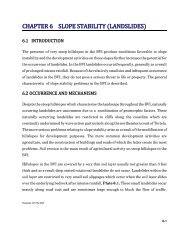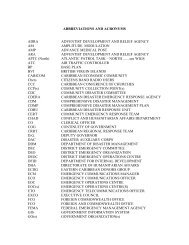Developers
Homeowners Handbook - The Department of Disaster Management
Homeowners Handbook - The Department of Disaster Management
- No tags were found...
You also want an ePaper? Increase the reach of your titles
YUMPU automatically turns print PDFs into web optimized ePapers that Google loves.
(1) Stormwater DetentionOne of the effects of developments is to significantly increase runofffrom the site. Stormwater detention facilities are designed to interceptthe runoff, provide temporary storage and reduce the peak runoff topre-development rates. Detention facilities can take various forms,such as open ponds and large pipes placed underground. The type ofsystem used depends on the size of the land being disturbed, cost,developer preference and other factors. Stormwater detention isusually used on larger construction sites, or in areas where the existingstrormwater system might be overwhelmed by any increase in runoff.(2) Better Site DesignThe goal of this approach is to preserve as much of the naturalfeatures as possible to minimize the amount of impervious surface.This is achieved by positioning the buildings in a manner that will allowportions of the natural terrain and vegetation to be preserved.(3) Stormwater InterceptorsThe term Stormwater Interceptor used here includes any man-madefeature that intercepts and safely conveys strormwater runoff. Theseinclude storm drainage pipes, culverts, channels and swales. Whateverthe system used, the objective is to intercept the runoff and allow it toleave the site in a controlled manner so as not to cause any issuesdownstream such as flooding and erosion.4.5 Erosion and Sediment ControlErosion is the process by which soil particles are dislodged from the landsurface and transported across the landscape. The most common type oferosion is caused by rain falling on exposed surfaces typically caused fromman-made disturbances that remove the natural vegetative cover andleaving loose bare soil. When the rain drops hit the loose surface, the soilparticles are broken up and as the rain accumulates, runoff occurs andtakes the dirt particles with it down the slopes. Eventually this muddywater enters the streams where some of the sediment is deposited alongthe stream bed and depending on the quantity and velocity of the flow, canalso cause stream bank erosion. If no action is taken, erosion will continueindefinitely with more soil loss and over time will reduce the flow capacityof the stream and cause blockage of road culverts, which will increase therisk of severe flooding and damage to human life and property and willincrease sediment input in coastline/ocean which represents a threat tomarine life, including coral reefs.29










